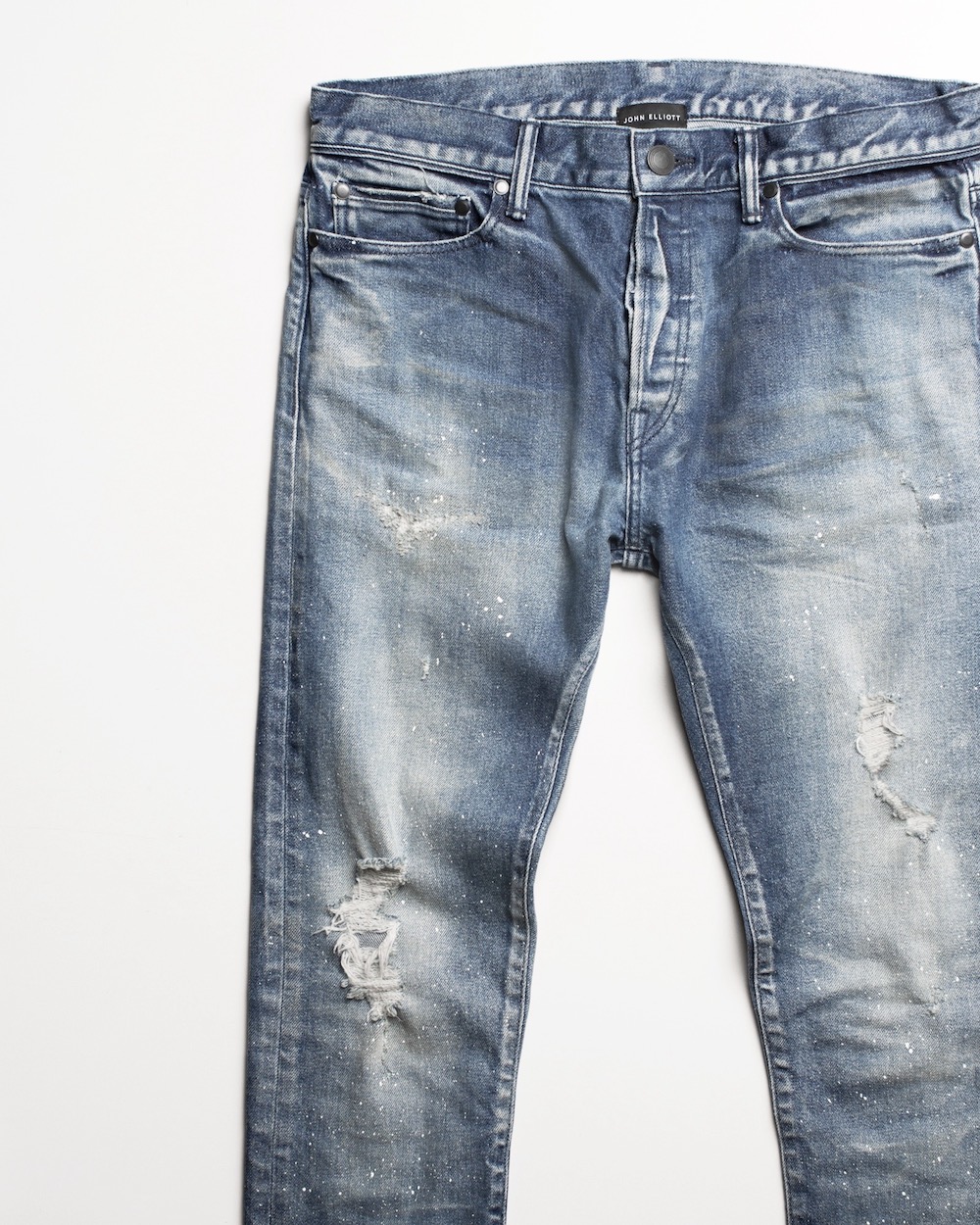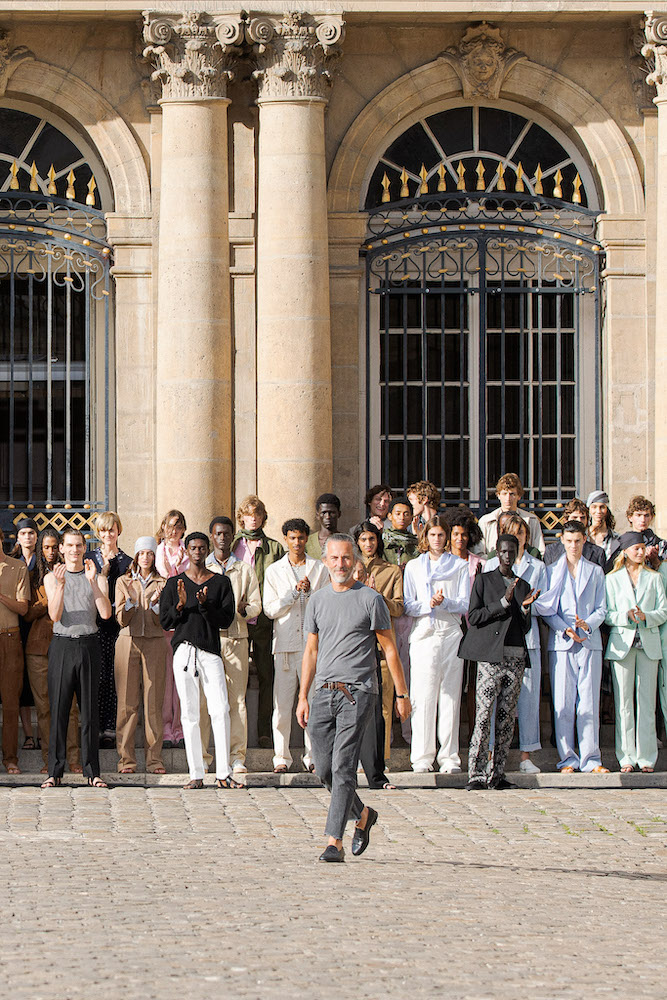John Elliott is the type of fashion designer that feels familiar—like a friend you haven’t met yet. Without even knowing him, fashion patrons sense an ease about Elliott; an unspoken mix of approachability and actuality. He’s calm and cool, evoking a quintessential L.A. attitude, but he’s serious about his business, too.
Since his start in fashion nine years ago, his approach to style has evolved, but much has stayed the same. For countless collections, a varying focus on basics has carried him to the finish line. T-shirts, trousers, shoes, and jackets elicit ease, but their details—like loose stitches, paneled fabrics, and asymmetrical necklines—stimulate enough personality to be statement pieces. Last year, he also opened his first brick-and-mortar store on Melrose Avenue, welcoming supporters in to explore more.

Men’s denim; courtesy of John Elliott.
Recently, amid the COVID-19 pandemic, the designer has pledged to give back to the community he knows and loves. Inspired by the healthcare workers in his family, he has launched the “Mainline for the Frontline” initiative, committing 10 percent of online sales to the UCLA Health Fund. Pieces from his “Mainline” collection—like the Hooded Villain jacket and Escobar sweatpants—have also been marked down to support the cause.
Whitewall spoke with Elliott to hear how his brand and personal style have evolved, what’s on his current mood board, and why he’s rethinking everything for a better future.
WHITEWALL: How are you doing during COVID-19? Are you working in you LA studio during this time?
JOHN ELLIOT: I’m doing great. I’m healthy and thankful for my family’s good health. This virus has put a lot of things into perspective—not only for me, but for the world. Right now, I’m sitting in my home with my daughter.
I’m thankful for my business, and for still being able to work on creative processes. I’m thankful to be spending extra time with my daughter. It may sound odd to say, but I think I may look back on these times with rose colored glasses.
WW: What’s keeping you inspired while being inside?
JE: The future. Although the human cost of COVID-19 is both horrific and tragic, I recognize that the circumstances of this moment may cause us to collectively emerge in a vastly different place. Having the ability to reset, to re-prioritize values and principles is really inspiring.
I have a section of my notebook dedicated to random thoughts of what the future might look like. It’s an exciting time to be alive, because in a weird way, our society might have needed an opportunity to change, and I hope that this is it.
WW: In 2011, when you and Aaron Lavee started your eponymous label, you said you intended to create a uniform for yourself. Tell us a bit about how that aim has evolved for your brand over time.
JE: You start out with this idea of solving your own problems and fighting your own cause. As you grow and get bigger, you try to hold on to those principals as much as possible, but also end up becoming part of the fashion machine. Right now, to be completely candid, I’m rethinking everything.
I’m going back to where I was in 2010-2011, when we were coming out of the recession. I’m having similar motivations and thoughts to create a wardrobe that’s timeless, based on principles of quality and unique design ideas. We’re trying to create a uniform—to have everything work together in a utilitarian way, where each piece is designed to be worn and layer together. It’s meant to allow you to look back on photos of yourself ten years later and appreciate what you invested in.
WW: Early on, you mentioned being fascinated with how prisoners were so innovative with so little, and it inspired a facet of a previous collection. Can you tell us a bit about this?
JE: I was interested in where minimalism can apply to areas of humanity outside of the arts, and I found this form of innovation to be out of necessity. When we started the label with $30,000, I found myself pushing the limits of areas that were basic in fabrication. I was inspired by the idea of how prisoners can innovate with very little.
WW: Do you have plans to work with a prison vocational training program or fabric workshop in the future?
JE: It hadn’t occurred to me, but as we find ourselves partnering with different areas of our own community, we can definitely add that to the list of potential causes worth bringing to the forefront.
WW: While designing, how you’re thinking of transparency and sustainability?
JE: Sustainability in the fashion industry is loosely thrown around and not entirely possible. To be honest, the way fashion works, and sustainability, are two somewhat opposite concepts. But, when you look at companies like Patagonia, you realize there is a way to approach this with grace and art, and work towards a more sustainable planet.
Given the circumstances the world is under right now, that’s basically all I’m thinking about for the future. You have to try. You have to examine all the areas through which your business conducts, and see if you can be more sustainable, more ethical, and try to improve. It’s very much top of mind right now.
WW: You source materials from around the world, like denim from Japan. When we asked you about this, you mentioned, “It’s hard to answer a question about sustainability and then pivot to Japanese denim, because you have to fly to Japan in order to do that.” Can you elaborate on that point?
JE: I’d like to recognize that these are different edges of the spectrum. In regard to Japanese denim, when we started the brand, the premise was to create a classic look that’s timeless, to create products that matter, and will stand the test of time. In our search for satisfying products I wanted to wear, the dream was to be able to source materials from the best in the world.
WW: Your minimalistic approach to fashion focuses on basics, and that’s something Japanese designers and producers excel at. What do you appreciate about the Japanese fashion culture?
JE: In Japan, they preserved a way of make that’s so unique and special. It’s pretty much world-renowned at this point. It’s something I feel lucky I’ve been able to be a guest, and a designer, of— who’s been able to be hands on, not only in the factories where the denim is sewn, but where it’s woven (down to the yarn level) and to have abilities to customize to that level.
Our partners in Japan are funneled through the pipeline of one of the brand’s founders, Nobu Yamamoto. He’s been able to help us make garments that are on par with luxury brands in Europe, and with heritage brands that released products in the ‘50s. That range is unique and has created a recipe that people fall in love with. It’s helped us create a hardcore group of brand followers.
WW: Tell us a bit about what’s seen on your latest inspiration board.
JE: Right now, it’s a return to minimalism. Its foundation is California outdoor spirit. It’s mixed with a tactility that’s viewed through a lens of monochromatic textures, with my own little personal quirks that will come out in the way we add details to garments.
It’s very much function and texture, that will feel like you’re investing in something rich. That’s what I’m seeking right now—these two things that feel Californian. The way I grew up outside in the hills—on concrete, on skateboards, black tops, and in the dirt.
WW: Tell us a bit about your personal style today.
JE: I’m a Dad, so I’m maturing. I basically wear one outfit every day. As the business has grown, and we’ve gotten bigger, I’ve found myself taking comfort in knowing how I’ll dress every day and not applying much thought to that.
I do have an expansive wardrobe, and I’m a bit of an introvert by nature, so I find comfort in trying things on and exploring. That’s one reason I love Japan so much—the freedom I feel in Tokyo to dress in a way that feels liberating. You have the ability to explore. But when I’m in L.A., I default to a uniform.
WW: What do you feel are today’s modern go-to basics for men? For women?
JE: For men, it’s a fit. It’s more about fit. It’s also a styling thing—two different silhouettes for bottoms that work with two different silhouettes of sneakers that work with two different styles of tops. That can basically be a modular wardrobe.
If it’s a slim-straight pair of jeans and a runner, then it’s most likely an oversized tee—something slouchy, drapey, washed, worn, and loved. The cotton has characteristics of texture and shows a richness—like a recycled cotton that we do quite well, I think. That’s one baseline for a uniform. The other would be oversized bottoms with a shoe you may have spent a fair amount of money on. On top, it’s something cropped. It’s about presenting yourself in a balanced way.
For women, for the next year, it’ll be about knits. And potentially something that’s a bit about celebration. Coming out of COVID-19, there will be time for fun, so it’s about skirts—an asymmetrical skirt, for example—mixed with a knit. It’s about mixing comfort with fun.
WW: Tell us about your recent women’s line launch, and that expansion for the brand. How does it complement, or stand apart, from the menswear?
JE: It’s a whole other business, really. When we first approached it, I was doing both. But with men’s and women’s combined, including pre-collections, it became eight seasons a year for a small team. It became clear that wasn’t sustainable.
We have a team now that’s highly capable. My wife is on the women’s side. We’re a tight knit group—all friends, living and breathing this project. When we first started, we didn’t fully grasp how demanding and different that customer is, but also the opportunity that exists there. Now that it’s growing so quickly, it’s exciting that people in the organization are involved who know our principals and the codes we’ve set. women’s is really starting to hit its stride.
Complementing men’s, it can show areas of curiosity with further depth. You can really push. Although the men’s marketplace has progressed by leaps and bounds in the last ten years, you can still push much further in the women’s sphere, if you will.






